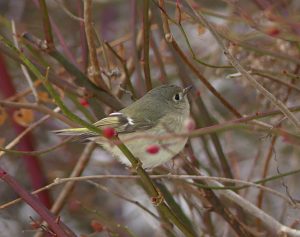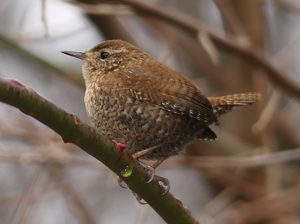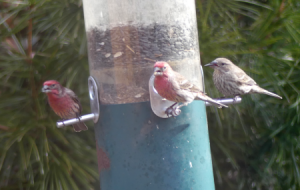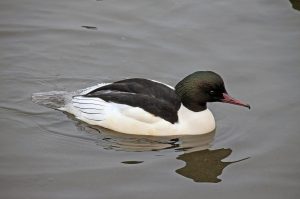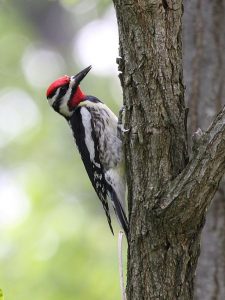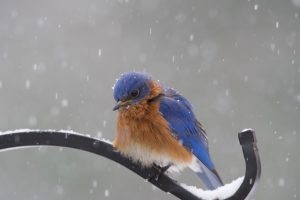Written by Gwyn Loud for the Lincoln Land Conservation Trust. She welcomes your sightings and questions at 781-259-8690 or at gwynloud555 (at) gmail.com.
Weather once again gave us surprises during the past month. January 11 and 12 broke records for warm temperatures, getting above 70º F, to the enjoyment of cyclists and runners. Visitors at Drumlin Farm noticed honeybees flying and a garter snake sunning. Brown marmorated stink bugs (harmless) seem more numerous indoors. Snowdrops are blooming by my house and, until the next snowstorm, the landscape is a palette of muted greens, browns and grays. Mud season has arrived, at least temporarily, revealing various animal tracks. Paradoxically, I spent much of the warmest day inside at an excellent “Climate Sunday” program run by Lincoln’s First Parish Church.
A major annual birding event, the Christmas Bird Count, occurred on December 29 and is well described as follows by Norman Levey, who coordinates the whole Concord Circle:
“The Lincoln edition of the Concord Christmas Bird Count launched its sixtieth count day in calm dry weather. Lincoln is one town of eighteen enclosed in a fifteen diameter circle that is censused every year the last week of December or first of January. The National Audubon Christmas Bird Count has a long and storied history going back 120 years to the turn of the 20th Century. Concord’s count was formed December 1960 and began with seven small parties in Concord and one volunteer in Lincoln.
Owls in the earliest hours long before dawn were quiet; our owl detective persisted until sunrise and tallied three great horned owls, one a juvenile at the Baker Bridge fields, and two calling adults near Conant and Weston roads by the first light of day. Valley Pond hosted two whinnying Eastern screech-owls and two more sounded out from the Van Leer Woods south of Drumlin Farm that evening. We dipped on barred and Northern saw-whet owls this year, although both were heard on earlier dates.
An early December deep freeze may have encouraged many of our birds to book a flight south. Our overall numbers notched a ten-year low and Flint’s and Farrar Ponds were iced over and the few ducks we had, including two American black ducks and one mallard, were wintering in still pools along Beaver Brook below St. Anne’s meadow.
Circle-wide records included two sora, a small chicken-like rail, and the first count day occurrence in forty years, at Concord’s Great Meadows along with three Virginia rails. Lincoln’s marshes were totally iced in and quiet.
High counts for the entire circle included ruby-crowned kinglet and marsh wren and an astounding record high count of 41 winter wrens, two in Lincoln. If there is a wet woodland or marsh edge with thicket tangles, fallen trees, and upturned roots one might hear (if not see) this tiny mite of a bird with an exceptionally large personality. Carolina wren, though not quite surpassing a record, has repopulated our circle after a bad winter for them several years ago. Call this the Year of the Wren. Lincoln had 22 of the circle’s 261 total.
Lincoln’s distinction for the count was spotting three of the five total yellow-bellied sapsuckers, a migratory woodpecker we do not see often and not well known to feeder watchers. All three were seen around Drumlin Farm.
Song sparrows were more abundant than the the ten year average and we may have a record tally for those but, sadly, American tree sparrow hit a record low, continuing a trend. Winter habitat loss caused by mowing and edge clearing on upland town agricultural fields may account for low numbers going forward and weather, climate, and migratory patterns over time should be considered.
Birds we don’t see every count in Lincoln included an Eastern towhee along Donaldson Field, probably living in propinquity to several feeders, a lingering chipping sparrow at Drumlin Farm, and a count-week Eastern phoebe seen the day before at Ricci Farms. Chipping sparrows are birds of summer but are becoming more common winter birds in December going into early January before they totally vanish along with the winter wrens upon the arrival of big winter snowstorms.
The record of sixty years shows some declining numbers and occurrences for the once reliable and abundant winter finches such as evening grosbeak (1,672 in 1983) and pine siskin (1,258 in 1977); Eastern meadowlark was irregular but reliable; American kestrel was an annual participant in the count and we are lucky now if see a single individual; ring-necked pheasant and ruffed grouse once appeared on every tally until the last decade of the 20th Century and now have vanished. New birds such as red-bellied woodpecker sashayed in around 1980 along with an abundance of common feeder birds such as tufted titmouse and Northern cardinal. House finches have become much more common than purple finches.”
The following people participated in the count this year, either in the field or counting at their feeders: Sandra Bradlee, Carolyn Bruse, Kim and Larry Buell, Tricia Deck, Jason Forbes, Deborah Gerstein, Annie Knowlton, Norm Levey, Gwyn Loud, Ron McAdow, Thomas Michel, Barbara Peskin, Bernadette Quirk, Rich Rosenbaum, Al Rossiter, Pam Sowizral, Lucy Sprayregen, Greg Stathis and Marjorie Durand, Dick Tatlock, Chris Thompson, Rob Todd, and Robin Wilkerson. Next year’s count will be on January 3, 2021; please join us!
Other than the Count reports, birds seen recently include common mergansers spotted on the Cambridge Reservoir and Flint’s Pond now that the water is open. Right on cue, I heard a chickadee give its spring fee bee call, triggered by day length, a few days after the solstice. Great horned owls have been calling in many parts of town; they are very early nesters, using old nests of birds such as red-tailed hawks rather than building their own. The female will lay the first egg in early February.
I cannot resist copying a recent post to a birding list serve by a visiting birder, Paul Peterson, from out-of-town. He wrote, “ The beauty of Eastern bluebirds at Mount Misery, as they drop from branches into the swamp for food.. The amazing aerial displays of a pair of common ravens over The Food Project fields. The wondrous call of a pileated woodpecker ringing through the woods at Mount Misery. The neat rattle call of a belted kingfisher as it fed in the Mount Misery Swamp. A red-tailed hawk dropping down into brush and coming up with a hapless vole at the edge of the Lincoln Community Farm. The loveliness of a flock of golden-crowned kinglets in the evergreen wood. The beautiful sight of dozens of common mergansers way out on Flint’s Pond. And if that weren’t enough, just being surrounded by non-stop tranquil beauty in this bucolic town put me over the top indeed.”
Many coyotes have been seen and heard in the past month and Norm Levey, while “owling” on Dec. 29, reported, “a lone fox barked from Donaldson Field. A fisher loped across Sandy Pond Rd. in the glare of headlights and vanished into the wildness of the night along Flint’s Pond.”
Ron McAdow captured a fascinating drama on video as coyotes, bald eagles and ravens visited a deer carcass on the ice on Farrar Pond. Watch the action at https://vimeo.com/381568461. Narrow tunnels, exposed on the surface of fields and lawns when the snow has melted, show the pathways traveled by voles and mice.
Finally, I urge readers to read a wonderful article, “Effortless Environmentalism” by Margaret Renkl in the January 13 New York Times.
You can link to it here: https://www.nytimes.com/2020/01/13/opinion/earth-environmentalism.html?smid=nytcore-ios-share
© Gwyn Loud


